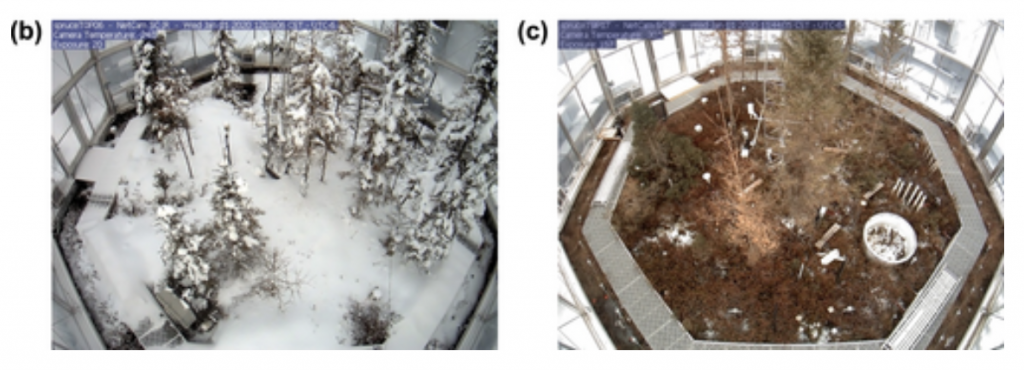A vicious cycle of warming temperatures and reduced snowpack in northern forests is more severe than climate models have shown and could lead to increased fire risk and permanent damage to ecosystems.
A new study of long-term warming experimental results led by Northern Arizona University ecologist Andrew Richardson found that even slight increases in temperature in the boreal forests can lead to a significant reduction in snowpack. Less snowpack means more light and heat is absorbed into the soil, which further increases the ground temperature, resulting in warmer air temperatures and more snowmelt. This means that the boreal forest, which stretches across the northern half of three continents and is home to many critical ecosystems, is changing even faster than scientists realized.
“Snow is really a critical part of winter in most northern ecosystems,” said Richardson, a Regents’ professor in the School of Informatics, Computing, and Cyber Systems and the Center for Ecosystem Science and Society. “Transitioning to low- or no-snow winters is going to have major implications for how these ecosystems ‘work.’ We’ll likely see negative impacts of low snow, such as frozen soils and damaged plant tissues, as well as reduced spring runoff and drier soils going into summer. Even if you don’t like winter, this is just bad news all around.”

The researchers used the U.S. Department of Energy’s SPRUCE Experiment in northern Minnesota to test their hypotheses. Large experimental enclosures, 30 feet wide and 20 feet high, were used to simulate future climate conditions, in which air and soil temperatures were manipulated using fans and heaters. Time-lapse digital photography was used to monitor conditions in each enclosure every 30 minutes, and snow depth and cover was estimated from the pictures. Comparing these results to historical data on snow depth and precipitation allowed them to get a better picture of the effects of temperature changes on the ecosystem and the changes in snow albedo, or reflectivity, which can affect soil and air temperatures.
The snow-albedo effect occurs when light reflects off snow-covered surfaces, which keeps the surface cooler. When snow melts and exposes the darker surfaces underneath, those dark areas absorb the light, which leads to an increased temperature, which melts snow, which leads to more light being absorbed, thus continuing the cycle.
What they learned wasn’t exactly a surprise: an increase in temperature led to more snowmelt. What was surprising was the severity of that snowmelt; they found that snow cover dropped precipitously with any amount of warming, no matter how small. That led to changes in the plant life and soil ecosystems in the boreal forest, including increased plant stress and mortality.

What this means for climate modeling is particularly important; results from this study can be used to evaluate how well current models are simulating the effects of warmer temperatures on the extent and duration of snow cover. Because the only variable is temperature, they were able to capture data that aren’t possible to isolate in the real world.
Although northern Arizona isn’t in the boreal forest, these findings herald what we likely will experience in future winters—less snow, more rain and a snowpack that doesn’t stick around as long.
“We’re kind of close to the edge already—you just have to look at how much more snow there usually is at the Flagstaff Nordic Center, just a bit higher in elevation, than there is in town,” Richardson said. “This may sound like good news for local residents who are tired of snow by the end of January, but it probably translates to more stressed forests.
“As someone who loves winter, this is a double dose of bad news—less snow and more fire danger.”
Heidi Toth | NAU Communications
(928) 523-8737 | heidi.toth@nau.edu




